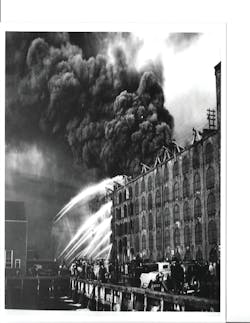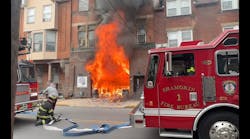VALENCIA, PA: JULY 3, 1913 – Five children were killed as a fire that was caused by an overheated stove swept through their home. The children, ages 11 years to 9 months, were in the home alone while their parents, who were dairy farmers, were out on a distant pasture milking cows.
PORT JEFFERSON, NY: JULY 4, 1913 – Authorities were investigating the origins of a fire that destroyed the village high school early in the day. It is believed boys who entered the building to ring the bell welcoming the Fourth of July started the fire. In previous years, unsuccessful attempts were made to ring the bell. The boys apparently guided their way through the darkened building by lighting matches and fled when the blaze erupted without sounding an alarm. The four-story, frame structure at the eastern end of the village was valued at $50,000.
WEST CLIFTON, NJ: JULY 4, 1913 – A lighted balloon set fire to a home on Plagett Avenue, destroying it before extending to two large barns, and a windmill. A man passing by saw the fire, broke into the house and carried out a woman and her two children. Two horses and many chickens were lost in the blaze.
NEW YORK CITY: JULY 5, 1913 – A fire that started when lightning struck the five-story building at 21 Warren St. in lower Manhattan. The third-floor office of the American Sports Publishing Company’s President James Sullivan, also housed the records of the Amateur Athletic Union of which he was Secretary-Treasurer. The valuable papers destroyed by fire or water included the records of the Olympic Games held in Stockholm Sweden in 1912.
RAHWAY, NJ: JULY 7, 1913 – A fire that originated in the rear of a hardware store a few minutes before midnight spread rapidly through the business section of town. An explosion rocked the building and showered the street with shattered glass scene when the flames reached a gasoline tank inside the store. Flames also engulfed the workshops of a construction company working on elevating the roadway. Train traffic to Philadelphia was halted for more than an hour by the heavy smoke and flames. The fire extended in both directions along Cherry Street and destroyed the 5-and-10 store, a butcher shop, two saloons and the workshop.
SOUTH NORWALK, CT: JULY 12, 1913 – A launch party composed of two adults and five children were enjoying a day on Long Island Sound when their yacht caught fire. The yacht’s captain, father of three of the children, was working on the stalled engine when a spark ignited gasoline in the bottom of the boat. The captain was thrown back and burned by the explosion. The family scrambled and pulled the captain to the rear of the yacht, where they all climbed into a small skiff and made their way to land. The yacht sank.
NORTH WEYMOUTH, MA: JULY 21, 1913 – The main building of the American Agricultural Chemical Co. plant and 11 cottages occupied by employees were destroyed by fire. The blaze was caused by sparks from a pile-driving engine that fell onto cargo of nitro being unloaded at the company’s docks. Several explosions followed, each sending sparks and flaming debris toward the main building and igniting a fire inside. The company’s fire brigade went to work aided by two fireboats sent from Boston. The huge building burned to the ground.
ARLINGTON, NJ: JULY 25, 1913 – Forty-two employees were injured in a fire and explosion in the Arlington Celluloid Co. As local volunteer firemen joined the company’s fire brigade in battling a raging fire inside the concrete building, a huge explosion threw the heavy slate, tin and gravel roof from the building across the sidewalk and onto the nearby train tracks. A dozen of the plant’s firemen were severely injured and were rushed to hospitals in critical condition. The chief of the volunteer fire department, Charles Greenfield, was also injured, but was able to return home. The valiant work of both departments held the fire to the storage building.
BINGHAMTON, NY: JULY 22, 1913 – It was just before 3 P.M. when a blaze that apparently was started by a discarded cigarette in a pile of rags in the basement ignited a blaze inside the huge four-story clothing factory. The automatic alarm was transmitted, but the fire already had great headway. The fire department’s closest apparatus was halfway across the city working at another fire when the alarm came in. This delay only worsened an already terrible fire situation. Most of the 125 women and young girls working inside the factory never moved when the fire gong sounded, believing it to be another fire drill. Two minutes later, smoke was pumping upward through every opening and shaft, filling the building with suffocating smoke and searing heat. Numerous girls were caught where they sat and died at their sewing machines. In all, 50 were killed by the tremendous fire that collapsed walls and twisted steel. Firemen dug through the rubble in search of the dead and missing.






